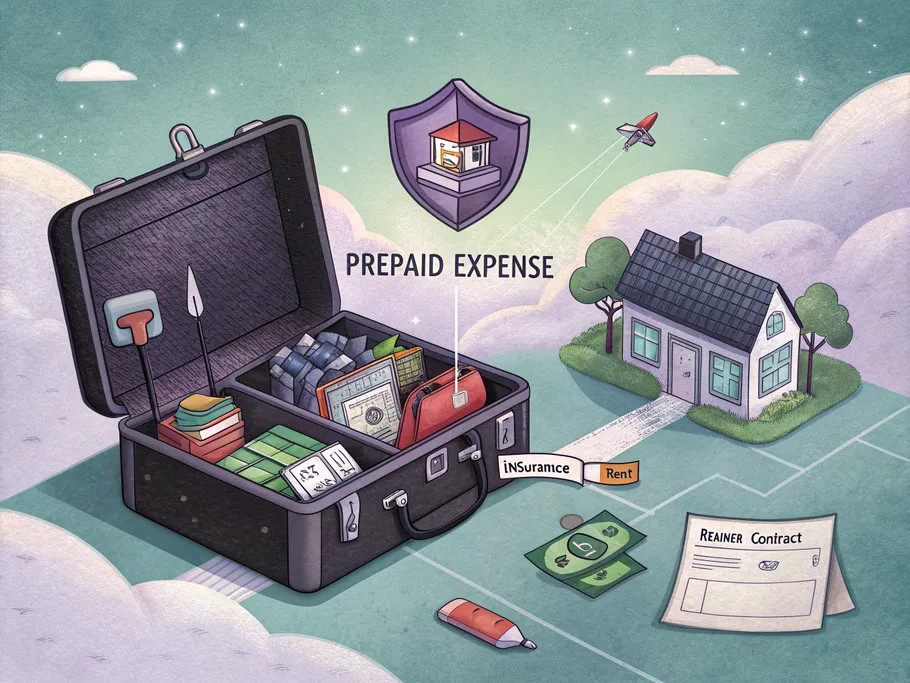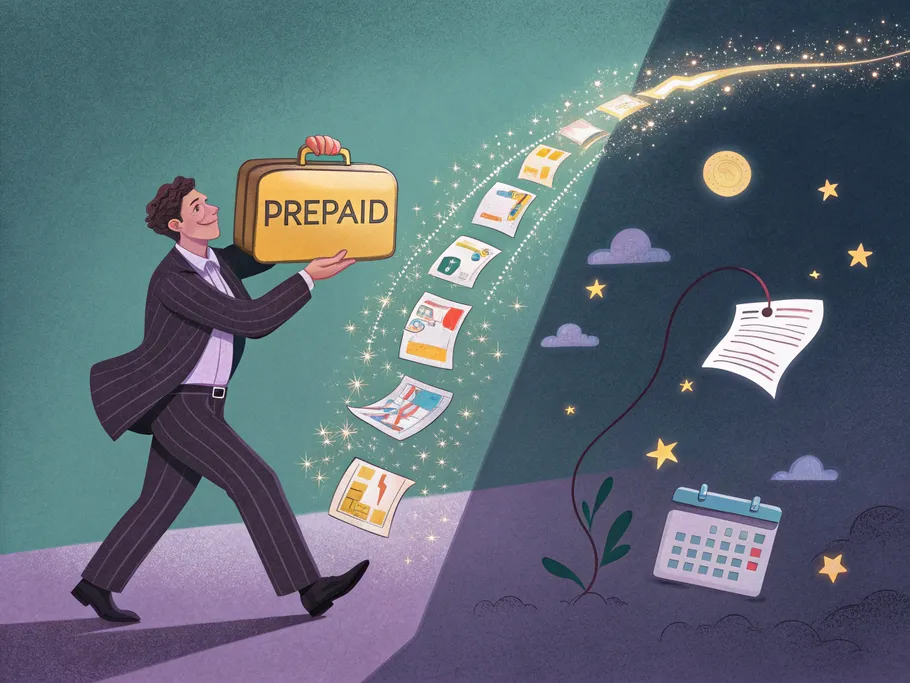Let’s settle the age-old debate: what are prepaid expenses—assets or expenses? Think of prepaid expenses as those concert tickets you bought months ago. You paid upfront, but the show (and the fun) is in the future. In accounting, when you fork out cash in advance for goods or services, your business logs it as an asset—because, technically, you’re sitting on future benefits. It’s accounting’s way of pretending you still own something valuable for a bit longer. Balance sheet magic!
The Real-World Dilemma: Prepaid Expenses Confusion

Meet Sarah, the bakery owner with a taste for discounts and confusion. She drops $2,400 on annual insurance and $12,000 for six months’ rent upfront. Now, she’s panicking, thinking she blew through $14,400 in January alone. Sound familiar? You’re not alone—prepaid expenses are the accounting equivalent of “do I call or text?”
Understanding prepaid expenses isn’t just about clean books; it keeps you from making facepalm-worthy financial decisions. For example, dropping a wad of cash on an annual insurance premium can leave your business gasping for liquidity if you’re not careful. Remember, accounting exists so you can avoid “oops” moments later.
Understanding things like this can feel a bit complex, like sorting through a lot at once. Just like those payments spread out over time, clarity often comes by taking it one piece at a time. Be patient with yourself in the process.
What Are Prepaid Expenses? (And Why Should You Care?)
Let’s cut to the chase. Prepaid expenses are payments made for goods or services you’ll use in future accounting periods. Unlike regular expenses (which hit your books the moment you use them), prepaid expenses are recorded as assets because they represent future value.

Prepaid expenses examples:
- Insurance premiums paid in advance
- Rent paid for future months
- Annual software or association subscriptions
- Multi-period software licenses
- Retainers for future services
- Advertising campaigns paid upfront
Say your boutique drops $12,000 for a year of e-commerce software. You expense $1,000 each month—no more, no less. It’s like a Netflix subscription, but for your business.
Why Are Prepaid Expenses Assets?
Prepaid expenses let you lock in goods or services without paying again later. That right is an asset (until you use it up). The matching principle (accounting’s way of keeping things fair) says expenses should show up in the same period as the revenue they help earn. That way, your financial statements don’t look like a funhouse mirror.
In accrual accounting, you record expenses when they’re incurred, not when you pay for them. That’s why prepaid expenses start as assets and slowly morph into expenses as the benefit is used. Usually, prepaid expenses are current assets (used up within a year), but if you’re prepaying for something that lasts longer—like a five-year lease—part of that sits in non-current assets.
You paid cash for future services. Your money’s gone, but accounting calls it an asset. Balance sheet magic!
Prepaid Expenses Accounting Treatment: The Process
Initial Recording
When you pay upfront for a future benefit, be sure that the item meets the company’s criteria for a prepaid expense, it goes down as an asset.
Amortization of Prepaid Expenses
Prepaid expenses are expensed gradually over their benefit period. Make monthly adjustments to recognize the portion you’ve actually used.
Adjusting Entries for Prepaid Expenses
At period-end, transfer the used-up bit from asset to expense.
Reconciliation
Keep your prepaid expenses honest:
- Maintain detailed schedules for each prepaid item
- Compare your ledger balances to your amortization schedule
- Fix any discrepancies (unless you enjoy chaos)
- Review contracts, invoices, and receipts for accuracy
Prepaid Expenses Accounting Examples
Rent Prepayment

Pay $120,000 upfront for a 12-month lease (record prepayment of 12 months’ rent):
| Account | Debit | Credit |
| Prepaid Rent | $120,000 | |
| Cash | $120,000 |
Each month, expense: $120,000 / 12 = $10,000:
Recognize monthly rent expense:
| Account | Debit | Credit |
| Rent Expense | $10,000 | |
| Prepaid Rent | $10,000 |
Prepaid expenses—accounting’s little game where you spend money now, but we call it an “asset” until you actually use the thing you paid for. Then, surprise, it’s just an expense.
Key Takeaways and Best Practices
- Prepaid expenses = future benefits, so record them as assets
- Expense them gradually as you use the benefits (matching principle, accrual accounting)
- Make regular adjusting entries to keep your financials accurate
Best practices for small businesses:
- Keep detailed records for each prepaid item
- Reconcile prepaid accounts regularly
- Standardize how you record and amortize prepaid expenses
- Use accounting software for automation (and your sanity)
- Read the fine print on contracts to get the amortization period right
- When in doubt, phone a friend (or a professional accountant)
Common Mistakes and How to Dodge Them
Mistakes:
- Expensing the whole prepaid amount at once (hello, distorted profits)
- Skipping adjusting entries (goodbye, reliable statements)
- Using the wrong amortization period
- Forgetting to reconcile prepaid asset accounts
How to fix it:
- Review your entries
- Calculate the right expense and asset balances
- Make correcting journal entries
- Update your amortization schedules
- Add month-end checklists to your process
Advanced Tips for Tech-Savvy Finance Enthusiasts
Remote work has shifted prepaid expenses from office leases to digital assets—think software subscriptions, online tools, and virtual services. Modern accounting software can automate amortization, bill management, and reporting, so you don’t have to play spreadsheet Jenga.
Stay sharp on accounting standards (ASC 606, anyone?) and tax law changes to keep your prepaid expense treatment on the up-and-up. Regularly consult professional resources, or risk being the financial equivalent of a flip phone in a smartphone world.
Frequently Asked Questions (FAQs)
- What’s the difference between prepaid and accrued expenses? Prepaid expenses are assets—payments made before you get the goods or services. Accrued expenses are liabilities—obligations you’ve incurred but haven’t paid yet.
- Why are prepaid expenses recorded as assets initially? Because they represent future economic benefits; they become expenses as you use up those benefits.

- How long can an expense be prepaid? Any period you agree to in the contract. The part used within a year is a current asset; anything longer is a non-current asset.
- What if a prepaid service is cancelled? If you get a refund, debit cash and credit prepaid expense. No refund? Write off the remaining balance as an expense. Ouch.
Takeaways: Prepaid Expenses—Your Ticket to Smarter Financial Management
Mastering prepaid expenses is like learning to ride a bike—awkward at first, but freeing once you get the hang of it. Recognize prepaid expenses as assets that slowly turn into expenses, and you’ll keep your financial reporting sharp. It’s essential for managing cash flow, budgeting, and avoiding those “wait, where did my money go?” moments.
And if you ever feel lost, remember: even accountants had to Google “what are prepaid expenses in accounting” at some point. Ask a pro when you need backup—and keep your business rolling forward.
